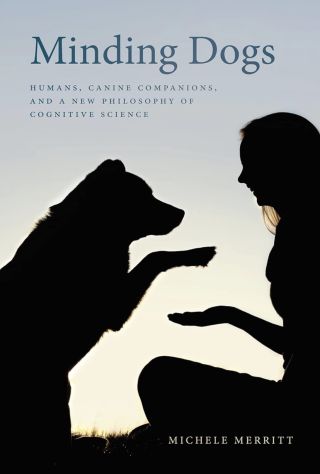Cognition
Minding Dogs: What They Think About, Feel, and Need From Us
Michele Merritt's book is a probing discussion of canine cognition and emotions.
Posted March 5, 2024 Reviewed by Monica Vilhauer Ph.D.
Key points
- Dogs ought to be central in our thinking about animals, not in spite of being domesticated but because of it.
- Merritt stresses that dogs' “lifeworlds” are vastly different than ours in important ways.
- She also focuses on the importance of looking at play behavior for gaining insights into the minds of dogs.
This post includes a conversation with Dr. Michele Merritt, Associate Professor of Philosophy, Department of English, Philosophy, and World Languages at Arkansas State University.
Dogs are popular household companions and also globally exist as free-ranging and feral individuals. It's an understatement to say that countless people, researchers and non-researchers alike—everyday dog guardians and citizen scientists—want to know what their and other dogs are thinking about and feeling. I'm glad that Dr. Michele Merritt was able to answer a few questions about her very interesting book Minding Dogs: Humans, Canine Companions, and a New Philosophy of Cognitive Science. Her title reminded me of my book Minding Animals where the word "minding" is used to acknowledge animals' active minds and that we also need to mind/care for them and offer them the best lives possible.
Marc Bekoff: Why did you write Minding Dogs?
Michele Merritt: As with many projects, my reasons for undertaking this were a mixture of academic and personal interests. Around the time Chaser the Border Collie was making a name for herself, I was training my dog to do similar things and I realized Chaser’s guardian, John Pilley, was correct: Chaser was not special. Any dog could be taught to map words to objects, so long as you spend plenty of time with them—not just training them, but playing with them. That was Chaser’s “treat” for mastering skills. The whole thing was a game for her. The learning was the play and the play facilitated the learning. Once I began digging into the research on dog cognition and human-dog interaction, I realized philosophers just had not paid attention to any of it. There was of course philosophical work on animal minds, but not so much on dogs. And there was certainly nothing by way of tying embodied and enacted cognition to dogs. So, I saw a gap in my discipline that needed to be filled.

MB: How does this book relate to your background and general areas of interest?
MM: In many ways, this book is an extension of my dissertation, where I defended the “extended mind” hypothesis, which basically argues that our tools and even the institutions we interact with are parts of our cognition. I began to wonder to what extent dogs could be coupled to us in the same ways our smart phones are, and the more I studied cases of human-dog interaction, the more I began to believe they could.
MB: Who do you hope to reach in your interesting and important book?
MM: Initially, the book was written for philosophers, to defend the “4E” approach (i.e. the Embodied, Embedded, Enacted, Extended approach) by examining dogs. But as I wrote, I realized it had broader reach. Wondering how living with dogs has actually transformed us is something many folks think about. So, I am happy to have added to that discourse. Finally, the chapters in my book about play and how crucial it is for learning in dogs is a reminder about how much we humans need to play also. With so many schools in the U.S. choosing to do away with music, art, physical education and other forms of play, I hope my book adds to the chorus of pushback against these measures.

MB: What are some of the major topics you consider?
MM: I trace the history of cognitive ethology briefly and make a case for why dogs ought be more central in our thinking about animals, not in spite of being domesticated, but because of it. I also argue, along with many canine researchers and anthropologists, that the way we think of domestication is often misguided, especially when it comes to dogs, and that really, the co-domestication of humans and dogs was one of the first examples of this “co-cognition” I talk a lot about in my book.
Cognition, I argue, often emerges from the interactions between both species. There are specific ways of “thinking-with” that occur only when two or more organisms are tightly bound together in some form of joint activity. For instance, in a 2015 paper of mine, I argue that when two dancers are co-choreographing an improvisational piece, there is a crucial feedback loop that both emerges from and is sustained by their continued interactions. They think in their movements together and, hence, the movements are part of the cognitive process that subtends their choreography.
It is the same, I argue, when a human and a dog are playing together and a new “game” or “routine” develops through the spontaneous yet coordinated actions. With dogs, it’s even more fascinating because we rarely rely on linguistic communication to facilitate these types of playful interactions. Thus, I spend the second part of the book focusing on play, but also the way in which interspecies play forces us to appreciate the great differences between humans and dogs.1 There has been so much focus on Chaser, and the extent to which she is “like a child” because of her linguistic abilities, but one of the things I argue in the book is that we ought to think about how there is this huge gulf between us and dogs. We live in the same houses, travel together, even eat the same food on occasion, and yet, their “lifeworlds” are vastly different than ours in important ways. Nevertheless, in playing with dogs, that gulf is bridged somehow. Examining how that bridge occurs is a large part of my book.
MB: Are you hopeful that as people learn more what's happening in dogs' minds they'll come to better appreciate their cognitive, emotional, and moral worlds, and that will help in the formation of better and deeper relationships?
MM: I do hope my book causes folks to reflect on how much we anthropomorphize dogs and how this might be to their detriment. While I agree with Gordon Burghardt, you, and others who think anthropomorphism is inevitable and even useful, so long as it’s done critically (or as you argue, biocentricially), I also urge us to appreciate how different we are from dogs and how we inhabit different worlds, even if we share the same house and sleep in the same bed.
For instance, we assume that dogs love traveling with us, and so lately people have been certifying their dogs as emotional support animals to circumvent pet prohibitions. While I am convinced animals can provide emotional support, I am not convinced that we always provide that same support to them, and dragging them on a cross-country flight might harm them in ways we have not even considered. This is not to claim that it is harmful, but rather a call to reflect carefully on the matter.
Since they don’t have a voice with which to raise concerns about how we treat them, I think we have a great responsibility to take care not to center ourselves too much when we assume we have their best interests in mind.
References
1) For more discussion of canine play click here.
Dogs Engage in Playful Teasing to Play Fair and Have Fun; Play Bows, Prey Bows, and Littermate Syndrome in Dogs; Dogs at Play: Feeling Safe, Having Fun, and Playing Fair; When Dogs Play, They Follow the Golden Rules of Fairness.
Canine Anthropology: A Major Shift in Dog-Human Relationships. (Marco Adda calls for a significant change in how dogs are viewed and trained.)
Are Emotional Support Dogs Always a Cure-All? Support Animals Aren't a Waste of Time or a Panacea; How to Have a Good and Happy Dog and Be a Better Human.
Bekoff, Marc, Dogs Demystified: An A-to-Z Guide to All Things Canine. New World Library, 2023.
_____. The Emotional Lives of Animals: A Leading Scientist Explores Animal Joy, Sorrow, and Empathy―and Why They Matter (revised and expanded). New World Library, 2024.




